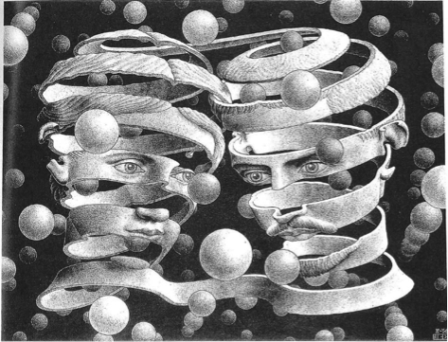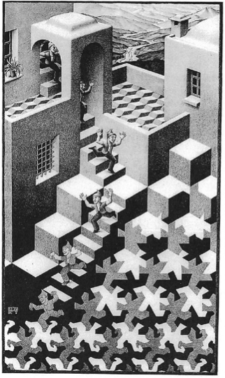Paratext #32 by Giuliana Racco
Paratext #32
December 19th 2018
by Giuliana Racco
Picture Giuliana Racco with Nenad Andric.
TMTMTM (collective in residence)
BeAnotherLab (collective in residence)
TOPLAP (collective in residence)
The Curious Case of Artist Collectives
As a member of the Hangar program commission and a former ex -in-residence artist, from “upstairs” I was amused when you asked me to write about the “downstairs” collectives. I have
often worked in collaboration with others, but the focus has always been on specific artistic productions, which differs greatly from the philosophy of the constellation of collectives that have resided and currently reside downstairs[1]. I was, therefore, curious to know how these artists perceive and define their activities within this specific context. What are their impulses and how do they operate in the intensified interdisciplinarity of the realms below?
First of all, the selection criteria that inhabit these spaces are different. The call values interdisciplinary experimental projects with contributions in terms of added value and support
services (…) to Hangar communities, with a strong focus on “describing feedback”. In addition, the collectives are involved in weekly Open Thursdays, evenings where the Hangar community and the general public are invited to learn from the research[2] so that there is an idea of “service” to the community and the public as knowledge transfer in exchange for the operating spaces, which is then interpreted in differing declines for each specific collective. This is fundamental in understanding Hangar’s role within the collective experiences, represented by three instances of new residents who appeared at Paratext on December 19, 2018.

M. C. Escher, Hands Drawing, 1948
The first group to speak was TMTMTM[3], confounded by Patricio Rivera, Belén Soto, and Ali Yerdel, who outlined their practice between technology and artistic research, mainly in terms of
service or production for other artists. However, they blur the line between artist and production collective by questioning production/reproduction methods, the concept of authorship, and power relations within production contracts. Brought together by what they saw as a lack of specific equipment and technology at Hangar, TMTMTM offers 3D printers, plastic modeling, consulting,
programming and programming, while creating a platform for collaboration, consulting, and workshops, including, for example, their techno-feminist inspired sex and technology workshop “Clitoris that pinch: 3D modeling and printing workshop to design self-defense weapons”. Based on open-source practices, the collective perceives itself as an open partnership (as a partnership they can turn to for funding) between art and production that strives for a different approach to production than the traditional market-driven model, recognizing Hangar as a free space to probe the sustainability of this model.

M. C. Escher, Bond of Union, 1956
Meanwhile, BeAnotherLab had just returned from a tour abroad with their Machine to be Another. This collective, revolving around the critical issue of “empathy,” has a specific technical and social function within the framework of social art practices, with an “open” character. This allows their project to be accessed and appreciated by a very diverse audience (e.g. from the World Economic Forum in Davos to public schools in Ireland). Describing itself as an anti-disciplinary group of artists, researchers, and activists, BeAnotherLab has since 2012 been questioning the relationship between identity and body by developing a technology in which two users exchange the perspective of the body; in the words of co-founder Christian Cherene, “creating the illusion of body transfer”, resulting in increased experiences of empathy by its users who, for a moment, feel, as if they were others. The result is a cross-border experiment between installation, research, performance, and pedagogy, linking innovative technology to sociology.

M. C. Escher, Three Spheres I, 1945
Finally, Lina Bautista and Iván Pau presented their cooperation as participants in the Barcelona node of the TOPLAP global network, aimed at articulating the community of live coders who
process the language of audiovisual programming. Through what they define as “live thinking “, Bautista and Pau generate logical music for experimentation, community, and events. In Barcelona, TOPLAP’s philosophy focuses on the technological appropriation and political response, while promoting self-technology and open-source philosophy with a gender approach. They also
organize workshops, consultation, and knowledge sharing, while contributing to Hangar’s dedication to sound art and encouraging logical and public thinking, workshops, hackathons, and algo-raves, events in which people dance to the rhythm of music generated from these algorithms. At this moment they were preparing for VIU, a live-coding festival held precisely in Hangar from
January 21 to 25.
These cases express only three potentialities of the possibilities of what an artists’ collective can be, and particularly in the context of hybrid, transdisciplinary, socio-aesthetic, and non-market
orientated spaces such as Hangar. They are, respectively:
- A service that raises the question of artistic production in a market-driven economy.
- A socially engaged practice that combines art and science.
- An experimental platform for research, production, and development of algorithmic music.
And this is just what is in Hangar now, the next round of collectives could and should be completely different. Distinguishable from each other, the common thread is the residency at Hangar, a
singular environment that allows for the existence of hybrid research, experimentation, knowledge production, and sharing that is not focused on the logic of the market start-up, but rather on the investigation of new sustainable models. If the artist’s “studio,” derived from the Latin studium, meaning “to study,” is traditionally conceived as the space where artists retreat to work, opening up for an occasional visit, the collective studio is expected to engage more frequently with a wider public, through consultations, workshops, and other services, in exchange for its operating spaces. The convening of these attitudes, above, below, and around, complements Hangar’s quest to be a hybrid case of collaboration between curious participants and the local community.

M. C. Escher – Cycle, 1938
[1] Old Can Ricart building is structured so that the resident artists’ studios are on the second floor, while offices, services, and other facilities (recording studios, equipment rental, co-working areas, etc.) are located on the lower level. Members of the various collectives are also housed here and enjoy a different status from the artists working upstairs.
[2] Noteworthy is the case of Befaco, a collective that resided in Hangar from its origins in 2010 and until 2018. During two years of Open Thursdays, Befaco shared knowledge with innumerable
curious people who wanted to learn how to build their DIY synthesizers. Regarding Befaco’s relationship with Hangar, their website says: “Befaco’s initiative is possible thanks to the support of Hangar, an artistic production center in Barcelona, which has given us support from the beginning, without this support Befaco would never have existed in this form” (www.befaco.org, last accessed on January 20, 2019).
[3] TMTMTM is the acronym for The Machine that Makes the Machine, referring to the 3D reproduction technology of Nikola Tesla’s projects and experiments.
Categories: Paratext report |
